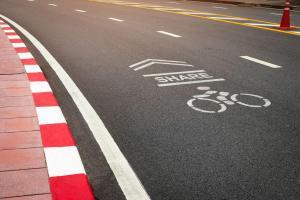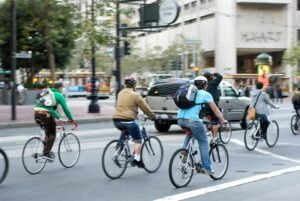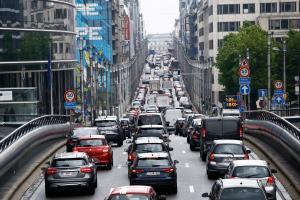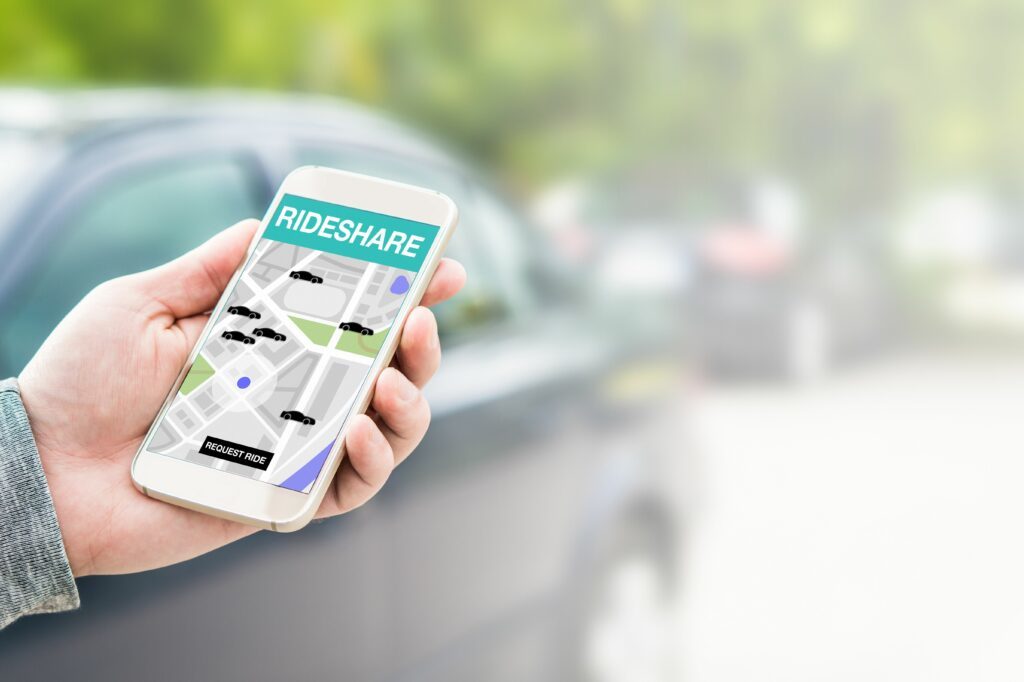A Journey into the Unknown: Integrating new mobility solutions
Uber, Lime, Bird: How do new mobility solutions integrate successfully in urban areas? Niklas Schmalholz has the answer
Ride-hailing, bike-sharing, e-scooters or shared taxis: inhabitants of cities have seen many new mobility providers appear on the scene in the last few years. Hopping on an e-scooter or ordering a taxi with a tap on your smartphone might be a quick, convenient solution to get from A to B, but it also creates challenges for traffic managers and city planners.
In comparison to traditional means of private and public transport, new transport solutions are driven by novel business models and technology. These technological advancements of the last 15 years have enabled car-sharing, Mobility as a Service (MaaS), as well as new modes of transport, such as shared bikes or e-scooters, the so-called micro-mobility solutions.
Across Europe, administrations of larger cities hope to reduce the negative impact of these new mobility services and capitalise on the opportunities they present. Since changes in legislation and traffic management can take years to implement, forecasts concerning the use of these new transport solutions are very useful. Therefore, EU-funded projects like MOMENTUM are analysing these waves of innovation to support administrations with their planning.
The MOMENTUM Project
The EU-funded three-year project supports cities to prepare them to handle emerging mobility solutions, by developing transport models and planning tools to predict the traffic impact. Since May 2019, the project has been running in four European cities: Leuven (BE), Madrid (ES), Thessaloniki (GR) and Regensburg (DE). Each city provides detailed information related to its most urgent challenges, such as MaaS and micromobility. Policy analyses, computer models and various other tools are used to provide forecasts and policy recommendations for cities on what to expect of emerging mobility solutions in the near future.Read more: https://h2020-momentum.eu/
A whole New Wave
Cities have survived several waves of emerging mobility solutions, but the challenges presented by these new means of transport are unlikely to go away. In the last few years, bike-sharing and other micro-mobility solutions have been introduced gradually. The first wave was the introduction of bike-sharing stations in cities. Many administrations created initiatives to install a wide-ranging set of docking stations for bikes in order to offer flexible commuting for bike users in a structured way.

Regensburg aims to integrate emerging mobility solutions, such as autonomous vehicles, as well as sharing of electric vehicles (EVs) and bikes
Whereas the first wave of bike-sharing options could be planned with stationary docks, which includes a central terminal that unlocks the parked bikes, the second wave consisted of free-floating bikes that could be picked up and dropped off everywhere in the city. Suddenly, bike-sharing was executed by private companies and bikes were parked in public spaces without clearly defined rules. Free-floating mobility solutions became even more unpredictable with the introduction of e-scooters, which can be regarded as the third wave.
These electric scooters, which were introduced in many European cities without a clear legislative framework, offered users an opportunity to bridge the last mile, trade the car for a light and nimble vehicle, or explore the city in an alternative way. E-scooters enjoyed great popularity, especially in the warmer months. As a result, the number of these vehicles increased drastically. The MOMENTUM project has observed this sudden rise in many metropolitan areas, especially in the partner city of Madrid. At the end of the assessment period in late 2019, the Spanish capital already had 16 e-scooter companies with more than 5500 vehicle licenses. This one example shows that emerging mobility solutions can introduce new ways of travelling, shift the use of transport modes or even hinder the use of public space. Other forms of emerging mobility solutions are autonomous vehicles and minibuses, the so-called people movers, as well as car-sharing and ride-hailing solutions, such as Uber, FreeNow and others.
As experts are predicting that these relatively new modes of transport will establish themselves throughout European urban areas, local administrations are gearing up to enhance their knowledge and try to predict future mobility patterns. EU-funded projects like MOMENTUM support these endeavours by focusing on three main aspects: influences on traffic planning, modal shift and holistic sustainable urban mobility plans.
In doing so, project experts aim to answer the following questions:
- How are the travel patterns of users in cities changing due to new mobility solutions?
- How can these new solutions be integrated into current and future traffic management and sustainable urban mobility plans (SUMPS)?
- How will these new solutions change the modal split?
- How can these new solutions help the decarbonisation of cities?
Centralised locations help citizens to find shared bikes
Everyone knows where to go if you want to take a train, but for car- and bike-sharing it might be unclear. Having well-known locations throughout urban areas, where citizens can find shared bikes and cars, or even switch from one mode of transport to another, can be very beneficial. These ideas were considered by Leuven, one of the four MOMENTUM project cities.
The Belgian university city aims to set up around 50 physical locations, which will combine several shared mobility solutions. These so-called ’Mobipunten’ will be installed throughout the city, helping citizens to find these emerging transport solutions more easily. These central locations also help users to switch from one transport mode to another.

EU-funded projects like MOMENTUM support these endeavours by focusing on three main aspects: influences on traffic planning, modal shift and holistic sustainable urban mobility plans.
If the emerging mobility solutions are to be successful, sufficient room needs to be provided on Leuven’s streets. Therefore, Leuven decided to extend their traffic circulation plans to a larger number of districts. Existing plans restrict traffic flows to fixed loops that are not connected to each other but instead lead back to the outer ringway of the city to give pedestrians and cyclists greater priority. By limiting the through traffic to specific streets, other areas are freed up. At a later stage, the goal is to develop an overarching, all-encompassing mobility plan for the wider region. The first goals focus on public transport and cycling infrastructure.
What if everyone takes the bus?
New mobility trends may change how people choose to get around a city. Regensburg aims to integrate emerging mobility solutions, such as autonomous vehicles, as well as sharing of electric vehicles (EVs) and bikes, which began recently. The Bavarian city gave the green light for the test of autonomous minibuses in the beginning of 2020. The first vehicles will drive through Regensburg’s business park by the end of 2020. The vehicles will have a capacity of up to six passengers and one operator, who can steer the vehicle in case of an unplanned manoeuvre or obstacle. During the two-year pilot phase passengers can use the vehicles for free.
Regensburg has also focused on the city centre by investing in a bike-sharing scheme with about 600 shared bicycles and e-bikes to start operation in 2021. The new scheme will have a mix between station-based and free-floating bicycles.
Since the implementation of most emerging mobility solutions is in the future, the main questions are:
- To what extent do the shared mobility services implemented in the city have an impact on car ownership and the reduction of car traffic?
- What is the impact of the new mobility options on air quality?
- What are the optimal pricing strategies of the bike-sharing system?
The MOMENTUM project is creating several travel models, which include the new transport options in combination with existing data on cars, public transport and cycling.
Similar to Regensburg, the city of Leuven is also a relatively small university city. Many of the more than 100,000 inhabitants study at or work for the university and its spinoffs. Even though Leuven’s railway station is a hub for more than 30,000 travellers and commuters per day - the modal split in Leuven is dominated by the private car, which is used by 60% of travellers, in comparison to public transport (11%), as well as cycling and walking (27%). The current traffic situation in the suburban area of the city is also affected by the influence sphere of Metropolitan Brussels, an urban centre with a 30km radius. As a result, Leuven is struggling with congestion and challenges in transport planning resulting from both its role as a commuter hub and as an urban attraction.
Ban polluting cars and introduce alternatives

Madrid’s revision of their strategy includes the recently established low-emission zone
The third aspect is the integration of emerging mobility solutions to reduce emissions and to improve the accessibility of public transport. This aspect is normally characterised in a sustainable urban mobility plan (SUMP). Future goals, such as the reduction of air pollution and CO2, the extension of the public transport network or other environmentally friendly investment plans are a key part of these SUMPs. After the initial creation of these plans, the MOMENTUM cities of Madrid and Thessaloniki are planning to update their goals and strategies.
Madrid’s revision of their strategy includes the recently established low-emission zone. Other measures, such as urban vehicle access regulations, which hinder certain cars’ ability to enter specific areas of the city, are also being debated. Additionally, emerging transport solutions like e-scooters have intensified the discussion between the municipality and citizens about the use of public spaces.
In order to support Madrid to plan its future transport policy, the project is taking a closer look at three districts with varying levels of shared mobility implementation. All three cases pose different questions for the researchers. The level of access to shared mobility varies, from the central district with high access, to suburbs where shared mobility is available recently, to districts without shared mobility. The experts consider it as a possibility that shared mobility has been used as a substitute for car trips.
Throughout the suburban districts, the accessibility aspect of shared mobility solutions plays a bigger role. The project assesses whether most of the citizens can utilise these new services. The novelty of the assessment is the implementation of shared mobility services in the forecast model. The inclusion of these variables is important, as mobility planners are struggling with freely available mobility solutions such as e-scooters and e-bikes, simply because of their continuously changing location. The analysis of the demand is important to understand citizens’ behaviour and the potential impacts of shared mobility within the city and its transport system.
Like Madrid, Thessaloniki also aims to update its SUMP, which would include scenarios for 2023 and 2028. One of the main challenges to be tackled is the safety of citizens and the lack of a dense public transport network in some parts of the city. Besides the implementation of the SUMP in general, the restructuring of the public transport network and promotion of walking and cycling by infrastructure investments are the major challenges.
Prepare for the unknown
Emerging mobility solutions have just started to conquer the European streets, but we can already imagine their future potential. Whether or not users are commuting to work with a shared bike, e-scooter, autonomous vehicle or by bus, cities should assess potentials now to prepare for the future. EU-wide research, as well sharing ideas and solutions, will help cities to create their own strategies.
Author: Niklas Schmalholz is a Project Officer at Polis Network
